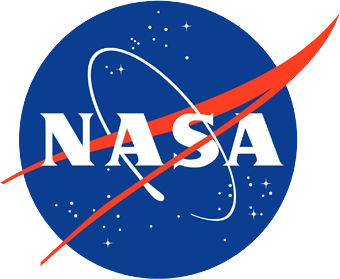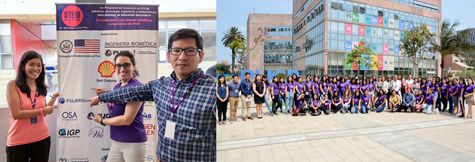Early Career Scientist Spotlight
Dr. Gonzalo Augusto Cucho-Padin (he/him/his)
Space Scientist
Space Weather Laboratory (674)
What is your research focus?
I am currently working on two research topics. The first one is associated with my Ph.D. research, which studies the exosphere, the outermost layer of the terrestrial atmosphere that extends from several hundreds of kilometers (~500 km) to several tens of Earth Radii (~60 RE). The most abundant component of the exosphere is atomic hydrogen (H) which interacts with every terrestrial plasma population (i.e., ambient ions) via charge exchange processes. In a charge exchange interaction, an energized ion picks up the electron of a neutral H to generate an energetic neutral atom (ENA) with similar momentum of the parent ion while a cold ion is also formed. Hence, the exosphere has a crucial role in dissipating magnetospheric energy from ring current ions via generation of ENAs, especially during geomagnetic storms where there is an enhanced injection of ions from the solar wind.
The study of atomic H is done through remote sensing of the resonantly scattered emission of far ultraviolet (FUV) light, specifically, FUV at 121.6 nm, also referred to as Lyman-alpha (Ly-a) emission. During my Ph.D. in Electrical Engineering, I implemented a tomographic technique to estimate the time-dependent, three-dimensional (3-D) density distributions of the middle exosphere (from 3 RE to 8 RE) using FUV data from the Lyman-alpha detectors (LAD) onboard NASA's Two Wide-Angle Imaging Neutral-Atom Spectrometers (TWINS) mission.
At NASA/GSFC and with the supervision of Dr. David Sibeck, I have applied a similar technique to reconstruct the 3-D density distributions of the outer exosphere (from 6 RE to 20 RE) using a wide-field Ly-a image acquired by the Lyman-alpha Imager Camera (LAICA) onboard JAXA's Proximate Object Close flyby with Optical Navigation (PROCYON) mission. In this case, H density distributions at this altitude are required to evaluate the charge exchange interactions between heavy charged solar wind ions and exospheric H atoms, which in turn, produce soft X-ray photons. Such emission will be used by the upcoming NASA's Lunar Environmental Heliospheric X-ray Imager (LEXI) mission to (i) image the dayside magnetosheath, a region between 10 to 13 RE from Earth where solar wind ions accumulate as they cannot directly penetrate the inner magnetosphere, (ii) investigate the dayside magnetic reconnection, the main mechanism to transfer solar wind ions towards the terrestrial environment, and (iii) assess their spatiotemporal response to space weather. My work on H density estimation directly supports LEXI's goal.
The second research topic is the Earth's Cusp modeling through a machine learning-based approach. One of the main objectives of the magnetospheric community is to understand the dynamics of the dayside magnetic reconnection as it enables the transfer of mass, momentum, and energy from the solar wind to the terrestrial magnetosphere. The study of the dayside magnetic reconnection can be conducted via analysis of ion flux in the Earth's cusp region, a zone where solar wind ions precipitate from the reconnection site to the ionosphere. For this purpose, I generated a regression model based on artificial neural networks, which can predict the 3-D structure of ion flux distributions when a set of solar wind inputs are provided. To implement this model, I have used in-situ observations of proton flux acquired by the ESA's Cluster mission and solar wind parameters supplied by the OMNIWeb database hosted by NASA’s Space Physics Data Facility (SPDF). The promising results have been presented as a poster at the last AGU Fall meeting 2022, and I am currently writing a manuscript that will describe the model implementation.
Information on my current research work can be found on github.
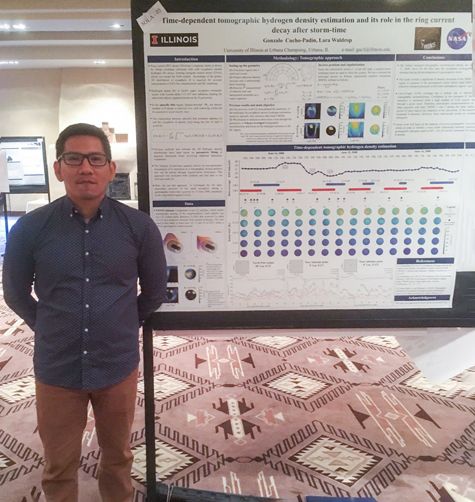
Credit: Gonzalo Cucho-Padin
Did you always know that you wanted to be a space physicist?
Nope. My passion for space physics started during my Ph.D. years, but the technical background needed to conduct research studies on this topic was built up several years earlier when I was working on agricultural remote sensing techniques.
After graduating from the Pontifical Catholic University of Peru (PUCP) with a BS in Electrical Engineering, I joined the International Potato Center (CIP) as a research assistant. Here, I built a low-cost multi-spectral camera and mounted it over a multi-rotor drone to measure the radiometric properties of large potato crops. This was my first experience using remote sensing techniques. Here, the observation of reflected sunlight by plant leaves in the near-infrared band provides information regarding how environmental variables such as water quantity and soil quality have a crucial impact on the development of a plant. Indeed, this experience laid the technical foundations for my current work.
During my Ph.D., I realized that the study of atomic H in space follows an identical scheme. Here, space-based optical instruments (e.g., TWINS/LAD, PROCYON/LAICA) provide observations of the solar Ly-a photons scattered by H atoms. Then, I used this dataset to extract information such as H density and its variable response to space weather. At the beginning of my Ph.D. studies, it was hard to understand the several (and simultaneous) mechanisms that explain the interactions between atoms and ions in the space. Although the learning process was slow, I ended up fascinated with these topics such that I cannot imagine myself working on some other area.
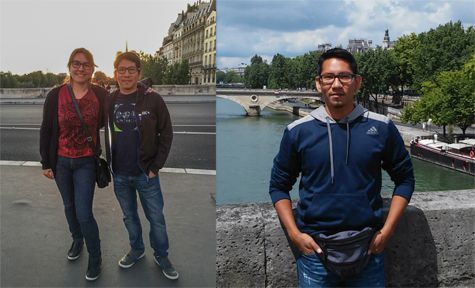
Credit: Gonzalo Cucho-Padin
What do you enjoy the most about your job?
One of the main activities I enjoy the most about my job as a space physicist is collaborating with other scientists. NASA/GSFC provides an excellent atmosphere for scientists to know each other's work and build cooperative relationships. For example, I participated in the "Ultraviolet Science at Goddard Symposium 2022" organized by the Exoplanets and Stellar Astrophysics Laboratory (Code 667). This scientific community develops instruments that observe exoplanets in FUV and extreme UV (EUV) to infer the properties of their atmospheres and evaluate their habitability. They found the terrestrial exosphere, my research topic, to be a source of contamination in their UV measurements, and they therefore needed to quantify such emissions accurately. Hence, I started an interdisciplinary collaboration with this group to provide more detailed information regarding exospheric emission that will serve for future UV instrument design. Furthermore, due to my work on machine learning-based modeling of the Earth's cusp, I became a member of the Center of HelioAnalytics, where I met knowledgeable researchers with whom I discuss current and future projects regarding artificial intelligence and machine learning (AI/ML) in Heliophysics.

Credit: Khushboo Jain
Are you involved in any upcoming space missions?
As a Ph.D. student at the University of Illinois Urbana-Champaign (UIUC), I had the opportunity to be involved in the proposal development and Phase A of NASA's Carruthers Geocoronal Observatory (CGO) mission led by my Ph.D. advisor Dr. Lara Waldrop. This mission will image the terrestrial exosphere in UV from the Sun-Earth Lagrangian point L1. I was in charge of developing software for estimating exospheric density distributions using simulated CGO's Ly-a images that ultimately served the FUV instrument design. CGO is currently in Phase C, with an expected launch in 2025.
I am currently collaborating with NASA's LEXI mission which will image the magnetosheath in soft X-rays from a lunar-based platform. I am developing tomographic techniques that will enable the reconstruction of the 3-D structure of the dayside magnetosheath from soft X-ray images. LEXI will be launched in 2024.
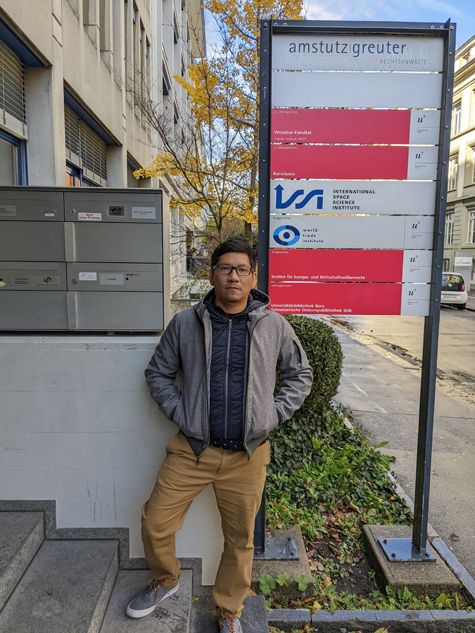
Credit: Gonzalo Cucho-Padin
Who inspires you?
I am inspired by my parents, whose real-life stories of struggle, hardship, and endurance always motivate me to persist in attaining my goals, whatever they are. I should also mention three impressive scientists I have met in my research journey whose careers and achievements have influenced my own goals. First, Dr. Roberto Quiroz, my former boss at the International Potato Center and the first Latin-American person I met who was involved in a NASA project. Dr. Quiroz represents the path and struggles of a Latin-American researcher to achieve an outstanding career in the US and to manage international collaborations which were beneficial for developing countries. Second, Dr. Lara Waldrop, my Ph.D. advisor and the first female Principal Investigator (PI) for NASA's Heliophysics missions. She represents the continuous struggle of a minority (women) in STEM careers. Finally. Dr. David Sibeck, my current advisor at NASA/GSFC. Besides his undoubted and impressive knowledge of magnetospheric physics, Dr. Sibeck always demonstrates leadership skill such as integrity, empathy, respect, and gratitude, required in an international/intercultural scientific team.
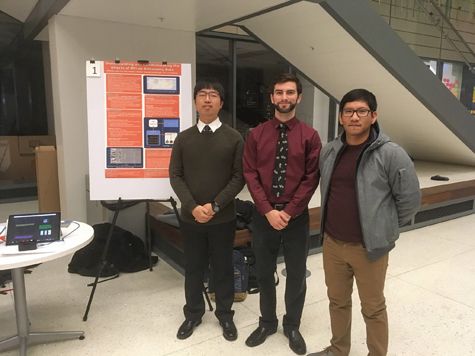
Credit: Gonzalo Cucho-Padin
Tell us about one project that has been particularly impactful in your field.
In 2020, I organized the workshop "STEM para Todas (SPT)" (STEM for young Peruvian women) with the sponsorship of the US Embassy in Peru, the Department of State (DoS), and several Peruvian institutions. SPT was created to motivate Peruvian girls to pursue Science, Technology, Engineering, and Mathematics (STEM) careers in an effort to reduce the gender gap in this area. SPT was a 4-day workshop in which 50 school students (in the 12-16 age range) from several Peruvian states (i) attended talks given by female scientists located around the globe, (ii) visited research laboratories at PUCP as well as the Jicamarca Radio Observatory, and (iii) participated in hands-on activities related to robotics and 3-D printing. NASA/GSFC was represented by Dr. Bea Gallardo-Lacourt (also affiliated with the Catholic University of America), who performed a remarkable and motivating talk about her path from Chile to NASA.
Credit: Valeria Benites Farfan
What are your future research interests and goals?
My future research interest is the development of a kinetic-based model of the exospheric hydrogen dynamics that allow us to understand (i) its role in governing the transient response of the terrestrial plasma environment to space weather and (ii) the mechanisms for permanent loss of Earth's water reservoirs. This modeling effort will complement my previous work on data analysis of Ly-a emission and would help to answer several open questions regarding neutral-ion interactions in the magnetospheric region.
Biography
Home Town:
Lima, Peru
Undergraduate Degree:
B.Sc in Electrical Engineering, Pontifical Catholic University of Peru, Lima, Peru
Post-graduate Degrees:
M.Sc in Computer Science, University of Central Florida, Orlando, FL
Ph.D in Electrical Engineering, University of Illinois at Urbana-Champaign, Urbana, IL

Link to Dr. Cucho-Padin's GSFC Bio
